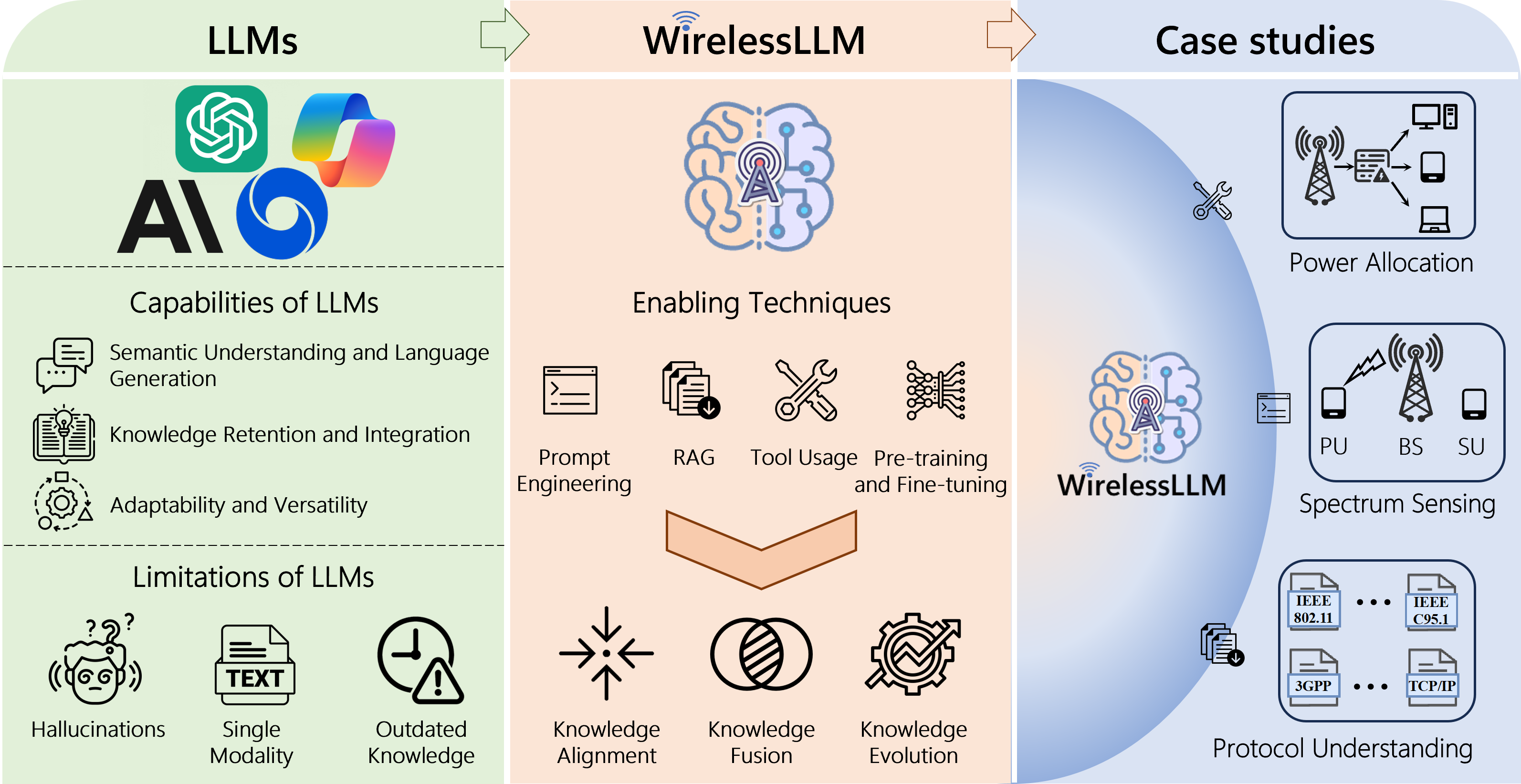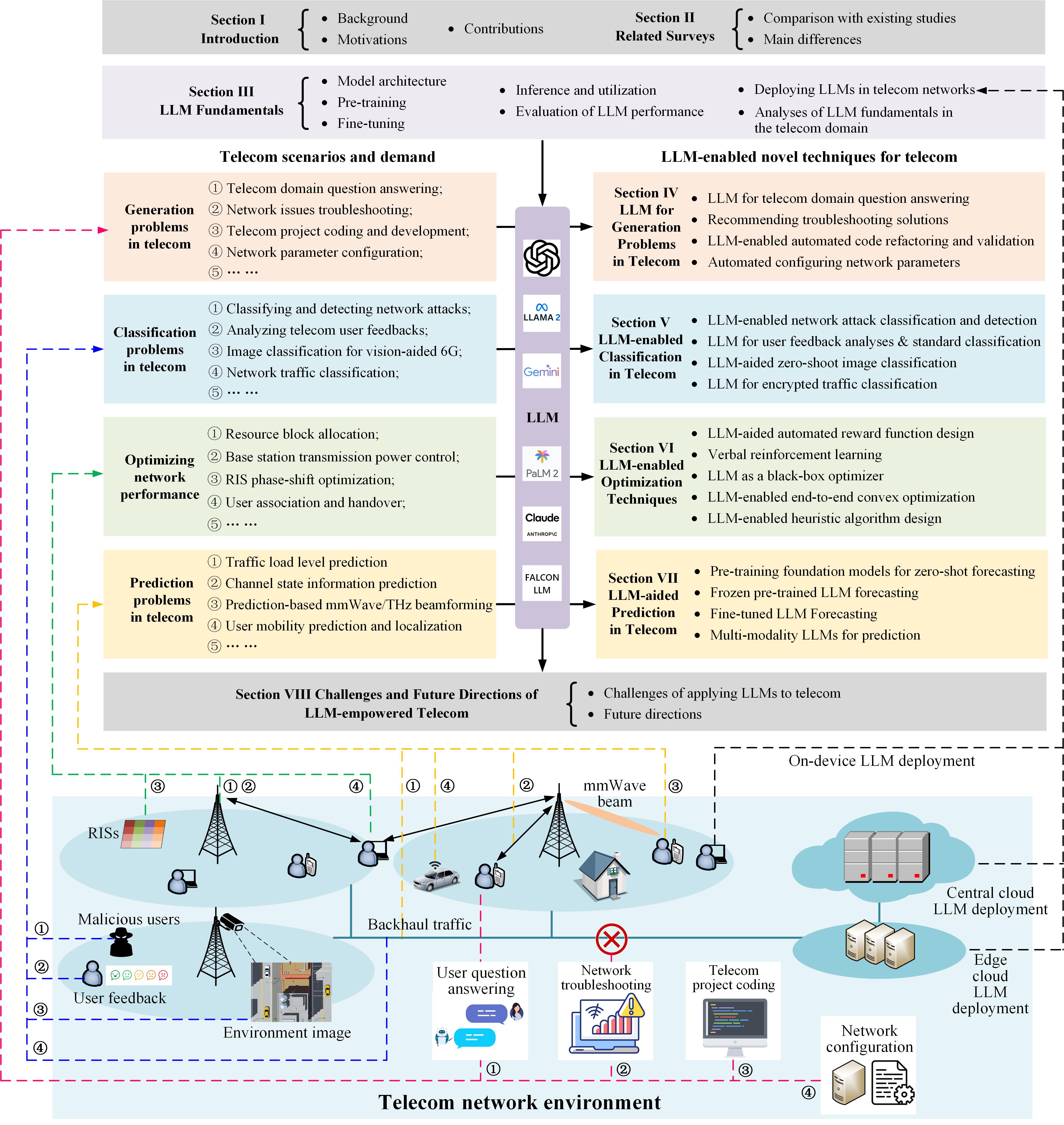WirelessLLM: Empowering Large Language Models Towards Wireless Intelligence
2405.17053

0
0

Abstract
The rapid evolution of wireless technologies and the growing complexity of network infrastructures necessitate a paradigm shift in how communication networks are designed, configured, and managed. Recent advancements in Large Language Models (LLMs) have sparked interest in their potential to revolutionize wireless communication systems. However, existing studies on LLMs for wireless systems are limited to a direct application for telecom language understanding. To empower LLMs with knowledge and expertise in the wireless domain, this paper proposes WirelessLLM, a comprehensive framework for adapting and enhancing LLMs to address the unique challenges and requirements of wireless communication networks. We first identify three foundational principles that underpin WirelessLLM: knowledge alignment, knowledge fusion, and knowledge evolution. Then, we investigate the enabling technologies to build WirelessLLM, including prompt engineering, retrieval augmented generation, tool usage, multi-modal pre-training, and domain-specific fine-tuning. Moreover, we present three case studies to demonstrate the practical applicability and benefits of WirelessLLM for solving typical problems in wireless networks. Finally, we conclude this paper by highlighting key challenges and outlining potential avenues for future research.
Create account to get full access
Overview
- This paper introduces WirelessLLM, a framework that aims to empower large language models (LLMs) for wireless intelligence.
- LLMs have shown remarkable capabilities in various AI tasks, but their application in the wireless domain has been limited.
- WirelessLLM leverages the strengths of LLMs to address challenges in wireless network design, optimization, and automation.
Plain English Explanation
Large language models (LLMs) are powerful AI systems that can understand and generate human-like text. These models have been incredibly successful in tasks like language translation, question answering, and text generation. However, their use in the field of wireless communication has been relatively limited.
The WirelessLLM paper introduces a new framework that seeks to unlock the potential of LLMs for wireless intelligence. The key idea is to harness the impressive capabilities of LLMs to tackle the complex challenges that arise in wireless network design, optimization, and automation.
Wireless networks are becoming increasingly sophisticated, with a growing number of connected devices, complex interference patterns, and the need for dynamic resource allocation. Traditional approaches to managing these networks may struggle to keep up with the rapidly evolving demands. By integrating LLMs into the wireless ecosystem, the researchers behind WirelessLLM aim to enable more intelligent, adaptive, and efficient wireless systems.
Technical Explanation
The WirelessLLM paper presents a comprehensive framework that leverages the strengths of LLMs to tackle various challenges in the wireless domain. The key components of the WirelessLLM framework include:
-
Wireless-Aware LLM Training: The researchers propose techniques to fine-tune LLMs on wireless-specific data, enabling the models to understand the unique characteristics and constraints of wireless networks.
-
Wireless Network Design and Optimization: WirelessLLM leverages LLMs to assist in the design and optimization of wireless networks, including tasks such as resource allocation, interference management, and network topology planning.
-
Wireless Network Automation and Control: The framework utilizes LLMs to automate various wireless network management tasks, such as fault diagnosis, performance optimization, and policy enforcement.
-
Wireless-Aware LLM Inference: WirelessLLM incorporates mechanisms to ensure that LLM-based decisions and actions are tailored to the specific requirements and constraints of wireless environments.
The paper presents case studies and experimental results demonstrating the potential of the WirelessLLM framework to improve the performance, reliability, and efficiency of wireless networks.
Critical Analysis
The WirelessLLM paper presents a compelling vision for integrating LLMs into the wireless domain. However, the researchers acknowledge several challenges and limitations that need to be addressed:
-
Data and Domain Adaptation: Effectively fine-tuning LLMs for wireless-specific tasks requires extensive and diverse wireless data, which may not always be readily available.
-
Computational and Latency Constraints: Deploying LLM-based solutions in wireless networks must consider the limited computational resources and strict latency requirements of these environments.
-
Interpretability and Explainability: Ensuring that LLM-driven decisions and actions are transparent and explainable is crucial for building trust and acceptance in the wireless industry.
-
Security and Privacy Concerns: Integrating LLMs into wireless systems raises questions about data privacy, model security, and potential vulnerabilities that need to be carefully addressed.
Addressing these challenges will be crucial for the successful deployment and widespread adoption of the WirelessLLM framework. Continued research and collaboration between the AI and wireless communities will be essential to unlock the full potential of LLMs in the wireless domain.
Conclusion
The WirelessLLM paper presents a compelling vision for empowering large language models (LLMs) to revolutionize the wireless industry. By incorporating LLM-based techniques into wireless network design, optimization, and automation, the WirelessLLM framework aims to enhance the performance, reliability, and efficiency of wireless systems.
The integration of LLMs with wireless technologies holds the promise of enabling more intelligent, adaptive, and autonomous wireless networks that can better meet the evolving demands of modern communication and connectivity. As the research and development in this area continues, the potential impact of WirelessLLM on the future of wireless intelligence is both exciting and far-reaching.
This summary was produced with help from an AI and may contain inaccuracies - check out the links to read the original source documents!
Related Papers
💬
Large Language Models (LLMs) Assisted Wireless Network Deployment in Urban Settings
Nurullah Sevim, Mostafa Ibrahim, Sabit Ekin

0
0
The advent of Large Language Models (LLMs) has revolutionized language understanding and human-like text generation, drawing interest from many other fields with this question in mind: What else are the LLMs capable of? Despite their widespread adoption, ongoing research continues to explore new ways to integrate LLMs into diverse systems. This paper explores new techniques to harness the power of LLMs for 6G (6th Generation) wireless communication technologies, a domain where automation and intelligent systems are pivotal. The inherent adaptability of LLMs to domain-specific tasks positions them as prime candidates for enhancing wireless systems in the 6G landscape. We introduce a novel Reinforcement Learning (RL) based framework that leverages LLMs for network deployment in wireless communications. Our approach involves training an RL agent, utilizing LLMs as its core, in an urban setting to maximize coverage. The agent's objective is to navigate the complexities of urban environments and identify the network parameters for optimal area coverage. Additionally, we integrate LLMs with Convolutional Neural Networks (CNNs) to capitalize on their strengths while mitigating their limitations. The Deep Deterministic Policy Gradient (DDPG) algorithm is employed for training purposes. The results suggest that LLM-assisted models can outperform CNN-based models in some cases while performing at least as well in others.
5/24/2024

Large Language Model (LLM) for Telecommunications: A Comprehensive Survey on Principles, Key Techniques, and Opportunities
Hao Zhou, Chengming Hu, Ye Yuan, Yufei Cui, Yili Jin, Can Chen, Haolun Wu, Dun Yuan, Li Jiang, Di Wu, Xue Liu, Charlie Zhang, Xianbin Wang, Jiangchuan Liu

0
0
Large language models (LLMs) have received considerable attention recently due to their outstanding comprehension and reasoning capabilities, leading to great progress in many fields. The advancement of LLM techniques also offers promising opportunities to automate many tasks in the telecommunication (telecom) field. After pre-training and fine-tuning, LLMs can perform diverse downstream tasks based on human instructions, paving the way to artificial general intelligence (AGI)-enabled 6G. Given the great potential of LLM technologies, this work aims to provide a comprehensive overview of LLM-enabled telecom networks. In particular, we first present LLM fundamentals, including model architecture, pre-training, fine-tuning, inference and utilization, model evaluation, and telecom deployment. Then, we introduce LLM-enabled key techniques and telecom applications in terms of generation, classification, optimization, and prediction problems. Specifically, the LLM-enabled generation applications include telecom domain knowledge, code, and network configuration generation. After that, the LLM-based classification applications involve network security, text, image, and traffic classification problems. Moreover, multiple LLM-enabled optimization techniques are introduced, such as automated reward function design for reinforcement learning and verbal reinforcement learning. Furthermore, for LLM-aided prediction problems, we discussed time-series prediction models and multi-modality prediction problems for telecom. Finally, we highlight the challenges and identify the future directions of LLM-enabled telecom networks.
5/20/2024

Large Language Models in Wireless Application Design: In-Context Learning-enhanced Automatic Network Intrusion Detection
Han Zhang, Akram Bin Sediq, Ali Afana, Melike Erol-Kantarci

0
0
Large language models (LLMs), especially generative pre-trained transformers (GPTs), have recently demonstrated outstanding ability in information comprehension and problem-solving. This has motivated many studies in applying LLMs to wireless communication networks. In this paper, we propose a pre-trained LLM-empowered framework to perform fully automatic network intrusion detection. Three in-context learning methods are designed and compared to enhance the performance of LLMs. With experiments on a real network intrusion detection dataset, in-context learning proves to be highly beneficial in improving the task processing performance in a way that no further training or fine-tuning of LLMs is required. We show that for GPT-4, testing accuracy and F1-Score can be improved by 90%. Moreover, pre-trained LLMs demonstrate big potential in performing wireless communication-related tasks. Specifically, the proposed framework can reach an accuracy and F1-Score of over 95% on different types of attacks with GPT-4 using only 10 in-context learning examples.
5/21/2024

Large Language Models for Networking: Workflow, Advances and Challenges
Chang Liu, Xiaohui Xie, Xinggong Zhang, Yong Cui

0
0
The networking field is characterized by its high complexity and rapid iteration, requiring extensive expertise to accomplish network tasks, ranging from network design, configuration, diagnosis and security. The inherent complexity of these tasks, coupled with the ever-changing landscape of networking technologies and protocols, poses significant hurdles for traditional machine learning-based methods. These methods often struggle to generalize and automate complex tasks in networking, as they require extensive labeled data, domain-specific feature engineering, and frequent retraining to adapt to new scenarios. However, the recent emergence of large language models (LLMs) has sparked a new wave of possibilities in addressing these challenges. LLMs have demonstrated remarkable capabilities in natural language understanding, generation, and reasoning. These models, trained on extensive data, can benefit the networking domain. Some efforts have already explored the application of LLMs in the networking domain and revealed promising results. By reviewing recent advances, we present an abstract workflow to describe the fundamental process involved in applying LLM for Networking. We introduce the highlights of existing works by category and explain in detail how they operate at different stages of the workflow. Furthermore, we delve into the challenges encountered, discuss potential solutions, and outline future research prospects. We hope that this survey will provide insight for researchers and practitioners, promoting the development of this interdisciplinary research field.
4/30/2024